There’s nothing worse than finally getting away on holidays, and not getting a good night’s sleep. There are plenty of options available to bring all the luxury from home into the bush, and the BCF camp bedding range can supply all the comfort, style and warmth to ensure your next outdoor adventure is a cracker.
What is the best camping bed?
Some people love roughing it in the great outdoors and could probably curl up on the ground no matter where they are, with just a blanket to keep them warm. Others prefer a little comfort and glam. So, before your purchase, ask yourself these questions to help choose the best camping bed.
Where will you use the bed?
The location of your campsite is important in determining how much padding you’ll need under you for a good night’s sleep. Additionally, if you’re on rocky grounds, you may want to consider buying something to lay underneath your camping bed, particularly if you're sleeping on an air mattress that can easily be punctured by pointy objects such as stray sticks and rocks. If you don’t like sleeping on the ground or have back/hip issues, you could benefit from a camping stretcher that is lifted off the ground so you don’t have to struggle getting in and out of bed. Also, the benefit of a stretcher will assist you in staying warmer in the cool nights as you’re off the cold ground.
What size do you need?
This question takes into consideration a few things. The number of people sleeping on the bed will help you decide on the size, keeping in mind whether the person is tall or if children will be sharing. BCF’s camp bedding range includes all sizes from single through to queen and everything in between. You'll also need to consider the size based on how much room you have to cart it around in your vehicle. The weight of the product may also influence your decision if you're an avid hiker, the bed will need to be compact and lightweight.
How often will it be used?
If you’re often on overnight adventures in the bush, it’ll be important to note the care and maintenance your camping bed will require. If you’re only going out occasionally, you may not be looking to spend as much on a high quality product. How often your camp bed will be used may also make you consider how easy it is to set up.
How important is a simple set-up?
If you’re constantly on the move, you’ll probably be looking for something you can set-up in a few short minutes. When you’re staying in the same spot for a while, you may not be in such a rush to get everything set-up straight away. Either way, you want to be comfortable and enjoy the time you have in the great Aussie outdoors. Our range of camping bed options include self-inflating mattresses (which you unfold, open the valve and walk away, returning to an inflated mattress that just needs a closed valve before you lay on it) to camping stretchers, air beds and hammocks.
How much do you want to spend?
Your budget may limit your choices when it comes to buying a camping bed, though if you’re not spending every other weekend exploring, a cheaper one may suffice. You can find anything from low-priced inflatable air beds right through to the ultra-comfortable, foldable stretchers that may set you back a few hundred. There's something for every budget!
#1. Types of Camp Beds
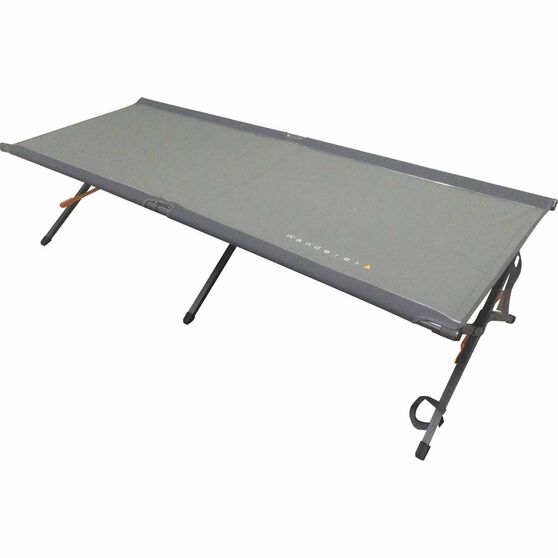
Stretchers
Stretchers offer a simple alternative to sleeping on the ground. They come in both single and double size, are fully collapsible and pack up into a surprisingly small carry bag. They're able to be slept on without any further padding, but for even more comfort, the addition of a foam or air mattress on top should have you counting sheep in no time. Stretchers are perfect for areas where the ground beneath the tent may be hard and uncomfortable or just for simply replicating your bed back at home. They also provide a great place to store bags and other items beneath to save space elsewhere. We also have a stretcher that suits most single swags to get you off the ground during the cooler months so that you’re not laying on a cold, hard surface.
You can also get bunk stretchers, the perfect bedding option for kids or to be used as a space saver within the tent. The bunks easily pack down into a small carry bag and they can also be set up to be two separate single beds. Bunks, like all stretchers, have a weight rating so make sure to buy the size and style to suit.
Ensure your camping area is as flat as possible to avoid an uneven bed! It's possible to chock the support legs to a small extent, but make sure the weight is distributed evenly amongst the legs to avoid damage.
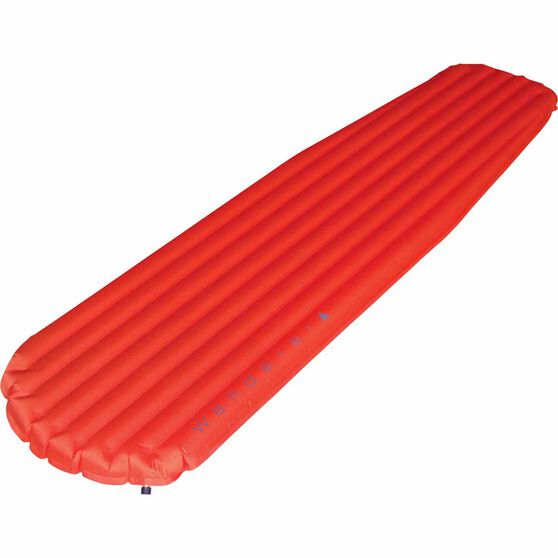
Hiking/Sleeping Mattresses
Sleeping mattresses offer a super compact and lightweight bedding option for those who don’t have the luxury of space on their travels. They pack down to a size that can be stored inside a hiking pack or easily secured to the outside. Hiking mattresses can be inflatable or be made of high density EVA foam. Despite their thin appearance, hiking mattresses are super comfortable either by themselves or when used to compliment a stretcher or swag.
In cold climates, the addition of a fleece sleeping bag liner and a sleeping bag that well exceeds the lowest expected temperature will ensure you don’t get cold during the night sleeping close to the ground.
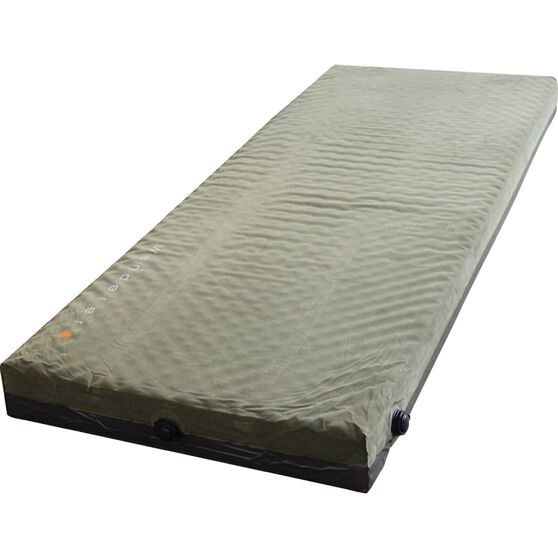
Self-Inflating Mattresses
If storage space isn’t an issue, the self-inflating mattress may be the perfect choice for you. Made with a compressible foam interior, they're one of the least labour-intensive bedding options available. Simply unroll and undo the screw ports and let the mattress do the rest, no air pumps required. Before heading to bed, simply screw the plugs back in and you’re good to go. Self-inflators come in various sizes and can be used autonomously or in conjunction with stretchers and swags. When packing up the mattress, simply remove the plugs, roll the mattress up, strap it and screw the plugs back in. Their only downside is the space they take up in transport.
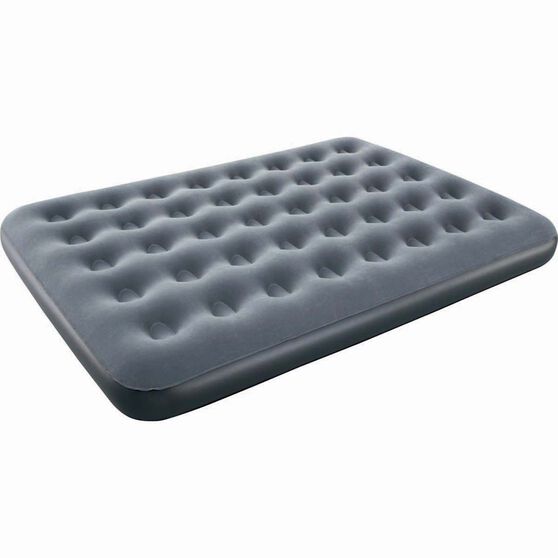
Air Beds
Inflatable mattresses, blow up mattresses or ‘air beds’ as they're commonly known, are a manual inflatable bedding option, generally used as a stand-alone bed. They have a durable PVC construction and require the use of a pump to inflate, unless you have a cracking set of lungs. Air beds are very comfortable to sleep on and are perfect for getting a good night’s sleep on an undulating surface. If used for an extended period of time, it’s normal to occasionally top up the air inside the bed to keep it firm and supportive. Because there is nothing inside the PVC shell, inflatables pack down to a very compact size and are easy to store.
In the unfortunate event of a puncture, fear not! Most air beds come with, or are compatible with, repair kits to patch the hole. Check to see if one is included with your bed, or alternatively, grab a kit for just in case. It’s important to note, PVC will stretch as the air temperature and pressure change once you’ve inflated your bed. For best results, inflate your bed when you get to your campsite, then check it before you go to bed and inflate further if needed. The PVC may have stretched, making you think it has a hole in it – it doesn’t, it just needs to be pumped up.
Also, there's a selection of airbeds with built-in 240V pumps that make a ripper addition to the home. No matter if the fam are joining you for the festive season, the littlies are throwing a slumber party, or you've got unexpected guests looking for a place to crash, one of these beauties will have them catching Z's in no time.
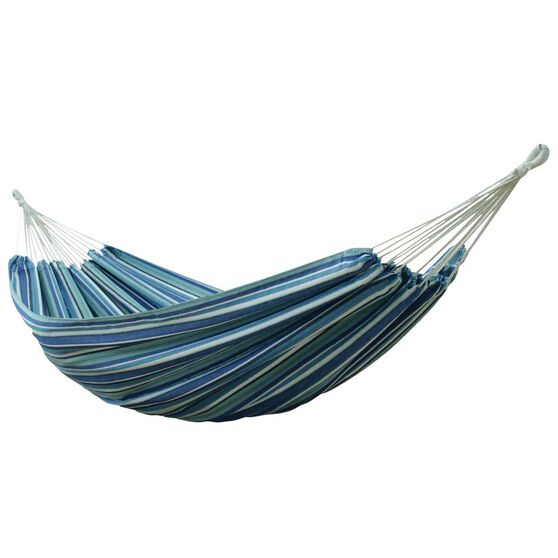
Hammock
Take that tropical island feeling wherever you go with a trusty hammock, providing a comfortable bed made of canvas, nylon or rope mesh that can be suspended between two objects, meaning you can set it up almost anywhere you like. Designed with vibrant colours, a hammock is much more than a swing, providing a tropical paradise in your home or at the campsite. A symbol of summer, leisure and relaxation, you can also invest in a hammock stand so that you don’t need to rely on finding two posts to set up.
#2. Size
When it comes to the size of your camping bed, a few things need to be considered, such as your comfort, the weight of the bed and the bed's own weight limit, transport and storage.
For comfort, consider the following points:
- Do you need a single, king single, double, queen or king bed?
- How long is the bed? If you’re tall, your feet may overhang, or you may not be able to get comfortable if the bed is not the right length.
- Width – how many people are you trying to fit into the bed?
Weight considerations include:
- How far do you need to carry it? Stretchers tend to weigh the most, so they’re not ideal for hiking.
- What is the beds weight limit? This will help determine how many people can comfortable fit on the bed.
For transport and storage, think about:
- How compact do you need the camping bed to be? You might have more space in a vehicle, but if you need to pack your bed into a hiking backpack, you may want to look at sleeping mattresses or hiking tents.
- How much space do you have in your tent for bedding? Bunk beds can stack higher (though you’ll need to ensure your tent is tall enough) while stretchers offer storage space for your bags and valuables underneath.
#3. Quality
The material used to make your camping bed will likely determine the quality, longevity and cost. Keep the following points in mind when selecting your new camping bed:
- The fabric's thickness is given in denier (D). The higher the denier, the thicker and more waterproof the material will be.
- Ripstop fabric is designed to stop rips and tears from spreading further, making them easier to repair.
- Nylon-made products are lighter, making them better for hiking and backpacking. Polyester is more waterproof, however, polycotton is more breathable than polyester and stronger yet lighter than cotton.
- Bed frames, like those on stretchers, are often made from metal which can be susceptible to rust. Powder-coated steel frames are rust resistant but an aluminium frame is lighter.
#4. Set-Up Simplicity
Whether you're having a romantic overnighter with the better half, or a school holiday escape with the kids, how long you plan on staying at the campsite is an important consideration. You may want a bed that sets up in a flash and leaves you more time for BCFing fun. Alternatively, if a longer stay is on the cards it's worth going for something that'll keep you comfortable for days on end. Here’s some tips to think about before your purchase of a new camping bed:
- Sleeping mats and self-inflating mattresses are among the quickest, easiest camping beds to set up.
- An air bed with a built-in pump will be easier and faster to set up than an air bed with a manual pump.
- Camping stretcher beds are the heaviest and have one of the longest set up times.

